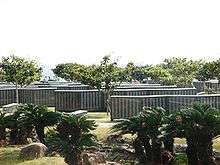Cornerstone of Peace

The Cornerstone of Peace is a monument in Itoman commemorating the Battle of Okinawa and the role of Okinawa during World War II. The names of over two hundred and forty thousand people who lost their lives are inscribed on the memorial.
Purpose
The Cornerstone of Peace (平和の礎 Heiwa no Ishiji) was unveiled on 23 June 1995 in memory of the fiftieth anniversary of the Battle of Okinawa and the end of World War II.[1][2] It was erected to: (1) Remember those lost in the war, and pray for perpetual peace; (2) Pass on the lessons of war; and (3) Serve as a place for meditation and learning.[1][2]
Name - Political background
Constructed by the administration of Masahide Ōta, and as detailed in his book of the same name Okinawa: Heiwa no Ishiji, the name 'Cornerstone of Peace' alludes to the Japan-US security partnership.[3] Ōta writes 'It would not be an exaggeration to say that the motivation which led to the building of this 'Cornerstone of Peace' has also become the basis for the people of Okinawa devoting heart and soul, night and day, to solving the military base issue.'[3] When US President Bill Clinton visited the Cornerstone of Peace in 2000 he delivered a speech promising efforts to reduce and consolidate US bases in Okinawa, as previously agreed by the US and Japanese governments.[4][5]
Design
The winning design, entitled 'Everlasting Waves of Peace', comprises concentric arcs of wavelike black granite stelai or screens.[2][3] These are inscribed with the names of all those who died, regardless of nationality and civilian or military status. The names are in horizontal order from left to right, and in their native alphabet according to place of origin.[1][2][6] The series totals some 116 stones, with the text running a total length of 2,200 metres.[7]
Inscription
As of June 2015, there were 241,281 names.[8] By order of inscription are 77,380 from other prefectures of Japan, by prefecture; 149,329 from Okinawa Prefecture, by hamlet; 14,009 from the USA, by unit; 82 from the UK; 365 from the Republic of Korea; 82 from North Korea; and 34 from Taiwan.[6][8] The numbers correspond to recorded deaths during the Battle of Okinawa from the time of the US landings in the Kerama Islands on 26 March 1945 to the signing of the Japanese surrender on 2 September 1945, in addition to all Okinawan casualties in the Pacific War in the fifteen years from the Manchurian Incident, along with those who died in Okinawa from war-related events in the year before the battle and the year after the surrender.[6] 234,183 names were inscribed by the time of unveiling and new names are added each year.[2][3][9]
Location

The site chosen for the memorial is Mabuni Hill in Itoman City, site of the Japanese headquarters and scene of heavy fighting in late June 1945 at the end of the Battle of Okinawa.[2][10][11] The area forms part of the Okinawa Senseki Quasi-National Park (沖縄戦跡国定公園).[12]
Related initiatives
The Okinawa Prefectural Peace Memorial Museum (沖縄県平和祈念資料館 Okinawa Kenritsu Heiwa Kinen Shiryōkan) was opened in 1975.[13][14]
In 2001 the Okinawa Peace Prize was established in order to recognize local contributions to peace in the Asia-Pacific region.[15]
The Centre for the Study of Pacific War Memories at the University of California Santa Cruz is developing a visualization project in order to reproduce virtually the Cornerstone of Peace while making use of recently declassified photographs from the archives of the Department of Defense.[16]
See also
- Okinawa Memorial Day
- Okinawa Prefectural Peace Memorial Museum
- Battle of Okinawa
- Peace education
- Ryūkyū Kingdom
- War memorial
References
- 1 2 3 "The Cornerstone of Peace - statement of purpose". Okinawa Prefecture. Retrieved 4 February 2011.
- 1 2 3 4 5 6 Weiner, Michael (ed.) (1997). Japan's minorities: the illusion of homogeneity (pp.169f.). Routledge. ISBN 0-415-13008-5.
- 1 2 3 4 "Recollecting the War in Okinawa". Japan Policy Research Institute. Retrieved 4 February 2011.
- ↑ Takahashi, Junko (22 July 2000). "Clinton lauds Okinawa's role". The Japan Times. Retrieved 4 February 2011.
- ↑ Butler, Desmond; Flaherty, Anne (23 September 2010). "Obama says US-Japan alliance a 'cornerstone' of world peace and security". Fox News. Retrieved 5 February 2011.
- 1 2 3 "The Cornerstone of Peace > Names to be Inscribed". Okinawa Prefecture. Retrieved 19 June 2015.
- ↑ "Peace Education in Okinawa (p.70)" (PDF). Japan International Cooperation Agency. Retrieved 4 February 2011.
- 1 2 "The Cornerstone of Peace > Number of names Inscribed". Okinawa Prefecture. Retrieved 19 June 2015.
- ↑ "Okinawa marks 62nd anniversary of WWII battle". The Japan Times. 24 June 2007. Retrieved 14 September 2007.
- ↑ "The Cornerstone of Peace". Okinawa Prefecture. Retrieved 24 June 2007.
- ↑ Huber, Thomas (1990). "Japan's Battle of Okinawa, April-June 1945 (ch.5, 'The Last Days')". Leavenworth Papers, 18, Combat Studies Institute. Retrieved 4 February 2011.
- ↑ "Battle of Okinawa National Memorial Park". Okinawa Prefecture. Retrieved 4 February 2011.
- ↑ "Okinawa Prefectural Peace Memorial Museum". Okinawa Prefectural Peace Memorial Museum. Retrieved 7 April 2008.
- ↑ "Okinawa Prefectural Peace Prayer Museum". Japan National Tourism Organization. Retrieved 4 February 2011.
- ↑ "Peace related activities". Okinawa Prefecture. Retrieved 4 February 2011.
- ↑ "The Okinawa Peace Memorial Park Project". University of California Santa Cruz. Retrieved 4 February 2011.
External links
- (English) The Cornerstone of Peace
- (Japanese) The Cornerstone of Peace
Further reading
Figal, Gerald (1997). "Historical Sense and Commemorative Sensibility at Okinawa's Cornerstone of Peace". positions: east asia cultures critique. Duke University. 5, 3: 745–778.
| Wikimedia Commons has media related to Okinawa Senseki Quasi-National Park. |
Coordinates: 26°05′42.7″N 127°43′30.1″E / 26.095194°N 127.725028°E